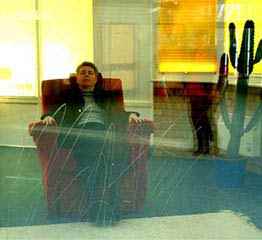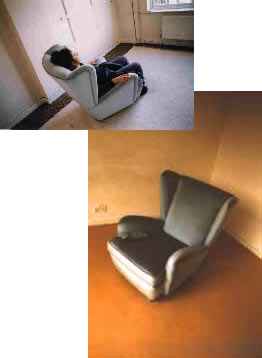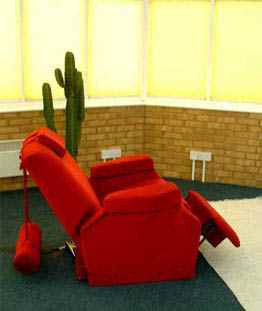” I’ve long been interested in the physical experience of music and have made two sonic armchairs which combine the vibrational sensations of music perception with aural to make new compositions. These chairs, with speakers immersed in their upholstery, create situations that transform the listening experience for the sitter, turning ‘weird’ or ‘boring’ music into something meaningful. People will queue for hours, have completely different experiences, love it and afterwards talk of the musical as well as physical and psychological experiences they’ve had. “ KM 2000
Matthews first experimented composing music for its physicality during the digital furnishings collaboration PlacemadeMobile (1997) with Mandy McIntosh and older residents, installing in empty flats in London and Glasgow.(England + Scotland Arts Council).
From investigating the residents favourite rooms, she often found an old armchair to be a favoured location, so installed a system of 7 speakers in a found old chair, reupholstered it and made a vibrational work (from Transatlantic recordings taken 32,000ft up inside a Jumbo jet) which moved, massaged and spiraled up, down and around the listener. This was Sonic Armchair (1997), for which she made 2 further works for this portable venue, creating queues throughout. eg. Sonic Armchair in Hamburg (2001) thrilled 40,000 visiting bottoms.
Red Chair (1999), was Matthews second Sonic Armchair, commissioned by the Millenium Exhibition Don’t Worry(2000) at Chelsea and Westminster Hospital. This was a luxurious, reclining and oversized development of the first, with 11 speakers, for which she made de cardiac bass.(2000) Red Chair also exhibited at Take a Ride (2000). Beckett Festival Glasgow. Tramway Gallery, Glasgow, Oct-Nov 2000 and Drop Time (2002). City Stages, Reading. Reading Station Concourse,Reading. Oct-Nov 2002
“These sonic armchairs have given all kinds of people ways in to unfamiliar music. Ten years on and I’ve developed a practical understanding of space, sonic design and architecture through performing with increasingly multi-speaker spaces, which has inspired an essentially collaborative research approach in the lab and the public.” KM 2006
Initiated by Matthews and with a NESTA Dreamtime Fellowship award, Music for Bodies was launched on Monday February 6th 2006 with a multidisciplinary think tank of professionals discussing the projects essential questions.
Due to the success of the projects first piece, Sonic Bed_London, work continued developing a new software instrument, audio spatialization system and compositions with musician/programmer David Muth, architect Alex Haw and Kaffe. Available playing in the Bed at the projects’ public launch, June 10th 2006, a streamed public forum was also held at Annette Works, Hackney, London E8. Following this, free workshops were held facilitating anyone wanting to make new music for it.
Up to now, music for bodies has concentrated on the Worldwide Bed project.with a strand of Sonic Benches more recently developed.
Ultimately, M4B intention is to continue to work in 2 strands as follows:
I : To develop new prototypes, interfaces/spaces, for music appreciation which interface via physical contact to the human body, carried out through collaboration with a team of professionals, learning from the sonic interfaces made so far.
II : To research and develop an understanding of the electromagnetic frequency maps of the human body and of the effect of different sonic vibrations on its different areas, through a practical study with a bio-resonant practitioner.
- To use what is learnt to build a new software instrument, a bio sonic mapping processor, (bsmp) collaborating with a programmer and acoustician mentored by an architect.
- To use the developing bsmp to make music with members of the community for the prototype interfaces. To install and test these interfaces in the community, eg the laundrette, café, bank, chip shop. To then pull it back to studio, evaluate, ask questions, another open forum, think tank and move the process on.
All aspects of the research will be documented at https://musicforbodies.net/
KM.2006




